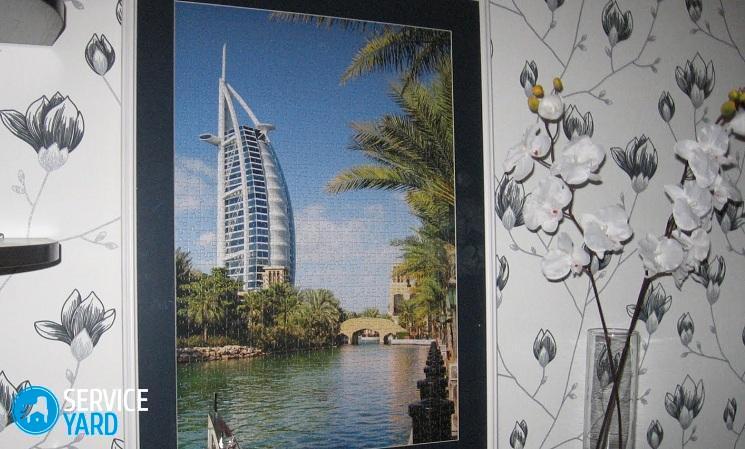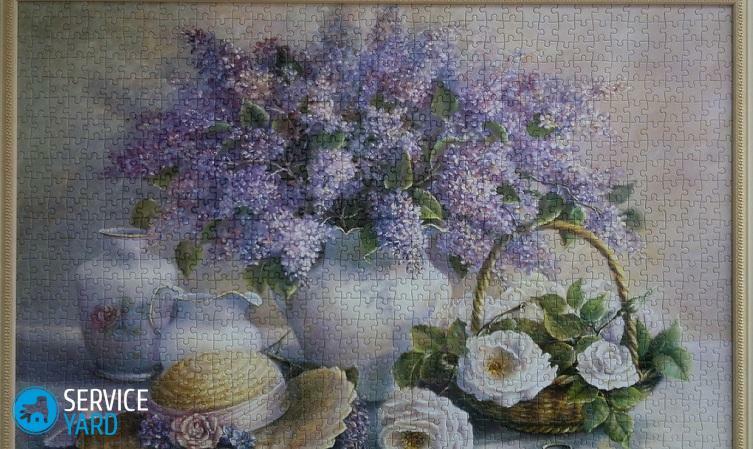
- Methods for gluing together the puzzle
- Basis for sticking the puzzle
- How can I glue puzzles?
- What can you make frames from?
Many children and adults love to collect puzzles. This activity develops imagination, horizons, logic and fine motor skills in children. Not surprisingly, the popularity of such entertainment is growing every day. The puzzle is an intrigue, a secret that you want to solve, so many adults are happy to purchase puzzles and collect them together with their children. But after assembling the puzzle, the question arises: what to do with it further? It can be disassembled or glued and made from it a real picture. Pictures from puzzles with their own hands can decorate any modern interior, especially this idea will appeal to children, because to collect a picture with your favorite cartoon characters and decorate as a picture - it's very interesting. But how to fix puzzles in the picture? To glue the puzzles went well and did not have to throw out the painstakingly collected picture in the trash, it is necessary to know some nuances. So, how to make a picture of puzzles in a frame?
to content ↑Methods of gluing together the puzzle
First of all, you need to decide how to fix the puzzles in the picture so that they do not break up. The simplest option is to glue them together. How to glue puzzles in a picture glue?
Pasting the puzzle on the front side of the
You can glue the puzzles from the front side with glue or tape. Before you begin the process of gluing, you need to clean the picture of dust, hair and other contaminants.
Important! In order not to stain the table with glue, place a tracing paper or baking paper under the bottom.
Pasting the puzzle from the wrong side of the
If you do not want to apply glue on the front side, you can glue it from the wrong side. But here the question arises, how to turn the puzzle face down. To do this:
- If you plan to glue this puzzle in this way, you must first collect it on an easily movable surface. It can be a sheet of fiberboard, plexiglas or a special mat for puzzles. In this case, you will have less problems with turning the puzzle - just cover the assembled mosaic with a durable material, for example, with another sheet of fiberboard and quickly turn the whole structure over to the other side.
Important! If your picture is very large, you can additionally fix the design with adhesive tape or clerical clips.
- You can use food film. In this case, you need to collect the mosaic on a substrate, which in size should be slightly larger than the puzzle itself in the assembled state. When the puzzle is assembled, wrap the whole picture together with the substrate with food film. For certainty, several layers of food film can be made. Then the entire structure should be turned gently turned face down, along the substrate cut through the food film. We turn the edges of the film aside and gently remove the substrate. Now you can glue puzzles, and the food film protects the table from the glue.
- If the mosaic was collected on a table or on the floor, you need to gently move the finished pattern on a dense surface.
- The most optimal way, especially for large paintings - is to glue first with the front, and then - from the wrong side. First glue the front side with glue, wait for it to dry completely. Now turn the mosaic will not be a big deal. Turn over neatly and glue with the wrong side.
Basis for sticking the puzzle
What to glue puzzles to make a picture? The following materials can be used as a basis.
Fibreboard It needs to be cut exactly according to the size of the picture. Trimming the edges after the puzzle is pasted can damage it.
- Apply a thin layer of PVA adhesive so that no dry spots remain.
- Remove excess glue immediately so that it does not leak to the front.
- Place the glued sheet on the inside surface of the assembled puzzle, press and immediately turn it face up.
- The adhesive that has fallen off after pressing is to be removed with a clean cloth.
- Allow to dry completely.
Important! Such sheets are optimal for creating large paintings, their surface is smooth, the puzzle is easy to glue, over time, it does not lose sight and does not deteriorate. But along with the pluses there are also disadvantages: these sheets need to be cut with special tools, besides the picture turns out to be quite heavy and requires special fastenings.
Polyfoam
A good alternative to fiberboard can be a thin foam that can be bought in construction stores. This is a lightweight material, which, moreover, is easy to cut. It does not deform from the glue and is not distorted after it dries, since it has a thickness of about 15 mm. But such a thickness is more likely a minus, since for framing a picture the frame will have to look for a rather massive construction that will hide such a thickness.
Ceiling tile
Such tiles come in different thicknesses and sizes. They are easily cut, placed in a thickness in standard frames and are quite affordable:
- For a basis it is necessary to choose a tile without a relief pattern, about 4 mm thick.
- On one tile a puzzle consisting of 500 parts is placed.
- If you have a large drawing, you can glue several tiles together with glue PVA.
- Joints between tiles are best made toothed.
- The puzzle is pasted on the back of the tile.
- After gluing it is necessary to remove excess glue and put the picture under oppression. You can just put the board on top. If this is not done, the design may deform during the drying of the adhesive.

Gauze, tulle
You can make it very simple:
- Treat with glue a regular piece of gauze or tulle of the appropriate size and attach to the mosaic.
- Surplus adhesive should be removed immediately with a cloth or cloth.
- After the glue has dried, it is possible to apply one more layer over the top to fix the result.
- The remaining edges of the gauze can be cut or used for tensioning on a frame or other surface.
Important! With this method, it is recommended to glue the puzzle from the front side, otherwise - the design will be fragile.
Adhesive or self-adhesive film
It is sold in rolls of different widths. The surface must be dry and clean without dust. The film size should be a couple of millimeters smaller than the size of the mosaic.
Next:
- Cut off the desired piece of film.
- Separate the paper from the film by about 5 cm.
- Attach the self-adhesive film to the surface and glue the separated edge.
- Then slowly and gently pull the paper from the remaining part.
- The other hand needs to smooth the film. You can use a towel, you can do it with your hands - as you like.
Important! To avoid bubbles, it is necessary to iron from the center to the edges. If bubbles have appeared, pierce them with a needle.
to the contents ↑How can I glue puzzles?
Now we need to figure out what to paste the puzzles to make a picture.
PVA
Adhesive PVA is used for bonding products made of wood, paper, cardboard, glass, leather, fabrics, etc. It is also suitable for gluing puzzles. It dries quickly and becomes clear after drying, so that you do not get confused by the white spots from the glue - they will soon disappear.
Important! Suitable for both the inside and the back.
Step Puzzle
This is a special glue for gluing together puzzles. It is often included in the kit. It is spread over the entire surface with a piece of foam or with a brush.

Powder adhesive from Clementini
This is an adhesive from Italian puzzle makers, which, as a rule, comes complete with puzzles. It needs to be diluted in water in a ratio of 1 to 3. The glue is quickly absorbed, with proper dilution it leaves no traces.
Silicate office glue
Despite the fact that it is not designed for such purposes, however, it does an excellent job and gives the picture a glossy sheen.
Scotch
A common scotch among puzzle lovers has been a regular scotch. They can easily glue the wrong side. First, glue your picture vertically, then horizontally.
to the table of contents ↑What can you make frames from?
There are many ways how to make a frame for a picture of puzzles:
- The easiest way is to buy a ready frame of a suitable size.
- Simple, but very nice frame will come from not sharpened colored pencils. In this case, the basis for the picture should be greater than the figure itself. At the edges, colored pencils of the correct size are glued. They can be glued to the glue "Moment".
- Beautiful frame is made from a ceiling skirting board. You need to cut it with a clerical knife and glue it to the base around the perimeter of the picture with the help of glue "Moment" or "Liquid nails".Then you can paint your frame with acrylic paints.
- You can make a frame from a shoe box, but this frame is limited by the size of the box. Cut a hole in the bottom of the box that matches the size of the puzzle. The mosaic itself needs to be glued on the lid from the box, we put the lid in the box, and the frame is ready. You can decorate it at will or just paint it.
In this article, you told you all the ways how to make a picture of puzzles in a frame. Keep the results of your creativity, because it is in such pleasant moments that life consists!



